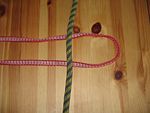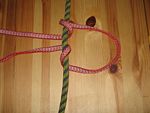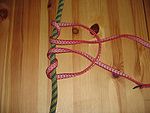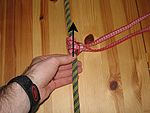(Added link to Storrick, denigrated use of ABOVE rappel backup, changed 'choice' to NPV.) |
(No difference)
|
Revision as of 03:31, 24 December 2005
A Prusik (or Prussik or Prussic) is a friction hitch used in Climbing, Canyoneering, Caving, Rope Rescue and by Arborists to grab a rope (sometimes referred to as a rope-grab). The term Prusik is used both for the knot, for the loops of cord, and for the action (to prusik). More casually, the term is used for any friction hitch that can grab a rope.
Advantages of a Prusik Hitch
Climbers carry Prusiks mainly for emergency use, as they are lighter than other options. Prusiks are fast to place on the rope, and with practice, can be placed with one hand. The loops of cord can be used as slings, and are thus multi-functional in a climbing environment.
Rope rescue teams such as Swiftwater rescue use a Prusik hitch as a 'pulley tender', to hold a line taut while tensioning a highline for a Tyrolean traverse, or in boat-on-tether and similar rescue operations.
Prusiks will work around two ropes, even two ropes of different diameters. Prusiks provide a high-strength and relatively fail-safe (ie, they will slip before damaging the rope or breaking) attachment, and are used in some rope-rescue techniques. Prusiks are good to use in hauling systems where multiple rope-grabs may be needed, and or where mechanical rope-grabs are not available.
Some prusik hitches (dependant on which variant is used) have the advantage of working equally in both directions. Most mechanical rope-grabs work like a ratchet, moving freely up the rope, but grabbing when a load in placed down on them. Traditional prusiks (such as those shown below) will grab when pulled by the tail, either up or down, and will slide when pushed by the barrel.
Disadvantages of a Prusik Hitch
For climbing a rope, Prusiks are slow and inefficient. Mechanical devices to grab the rope are available that are easier and faster to use, but of course, heavier, more expensive and bulkier.
Related Hitches and Equipment
The Prusik hitch is a specific hitch. Other friction hitches can be used to create a rope-grab from small cord (ie, cord that is smaller than the rope being grabbed) or webbing slings. The two main alternatives are the Bachman knot and the Kleimheist. Each has its advantages and disadvantages, mainly in how easy they are to use for climbing a rope. Another variation is the AutoBloc, used by some people as a backup knot while rappelling.
A Purcell Prusik is a related cord popular among cavers and rope-rescue people. A somewhat longer loop than the normal prusik is used around the rope, then a second prusik is used around the cord loop itself to form a foot loop. The foot loop is then easily adjusted in length and position.
A Prusik-Minding-Pulley is common in rope rescue. The rope to be pulled is passed through a pulley, and a prusik is tied on the loaded side. When the rope is pulled, the prusik rides against the pulley and the rope slides through it, but when the rope is relaxed, the prusik slides away from the pulley and grabs the rope. Thus, the combination acts as a ratchet.
Equipment
A prusik hitch is tied using a loop of nylon accessory cord or a sling. The length of this loop depends on the application it is being used for. For instance, the loop used for an Auto-Bloc might only be 20cm, whereas the foot loop for climbing a rope might work better with a length of 100cm or more. As a general rule, longer loops are preferable over shorter ones, as a loop can always be shortened (by tying a knot in it), but cannot be lengthened if the application changes.
The effectiveness of the prusik hitch relies on the surface area between the hitch and the mainline, and the diameter of the cord used. Normally the greater difference between the diameter of the cord used for the hitch and the mainline, the greater the ability for the hitch to hold. It should be noted, however, that the smaller the diameter of the cord used the lower it's safe working load. In addition, smaller diameter cords are often harder to work with as they often jam tight when placed under load, and the size of the rope makes them hard to handle when wearing gloves.
Tying the Prusik
The prusik is tied by wrapping the loop around the rope a number of times (depending on the materials), but usually 3-5 times, and then back through itself, forming a barrel around the rope, with a tail hanging out the middle. When the tail is weighted the turns tighten around the main rope and grab. When weight is removed the loop can be slid along the rope by placing a hand directly on the barrel and pushing. The trick is, if it grabs well, then it is hard to slide along the rope. Breaking the prusik free from the rope after it has been weighted can be difficult, and is easiest done by pushing the bow, being the loop of cord which runs from the top wrap, over the knot to the bottom wrap, along the tail a little. This loosens the grip of the hitch and makes movement easier.
File:Prusikhowto4.saa.jpeg Step 4. |
File:Prusikhowto5.saa.jpeg Locked while holding tension. |
It is a matter of debate as to whether the rope grip can be increased by passing through the bight additional times:
Applications
In addition to being a useful rope-grab for rope-rescue applications, prusiks are popular for:
- "Rappel Backup"/"Self-Belay Below The Device": A prusik is placed below the descender and controlled with the brake hand. It acts as an automatic 'dead man's handle' should the climber be incapacitated or require the use of both hands. Careful setup of the rappel backup is critical, or it will not work. An AutoBloc knot is most widely used in this application. This technique is used by some rappellers, and not by others.
- "Rappel Backup"/"Self-Belay Above The Device": A prusik is placed above the descender and controlled with the hand not being used as the brake hand. This technique has been demonstrated to be both ineffective and dangerous, and is no longer used.
- "Prusiking" or ascending the line: Two prusiks used in tandem can be used to climb a fixed rope. One prussik is attached to the "belay loop" sewn onto the front of a harness and the other is attached to a longer length of cord reaching to one foot. With one loop attached to the rope above the other the climber can then stand up in the foot loop, slide the prusik hitch of the waist loop further up the rope and then "sit" down on it. Once sitting, they can slide the foot loop up the rope and repeat the process.
- "Escaping the Belay": In a lead-climbing situation, should the belayed climber become incapacitated in a position where they cannot be safely lowered to the ground, the belayer must escape the belay in order to effect rescue. With the belay rope locked off with one hand, the belayer can tie a prusik to the rope with the other hand, and transfer the load to a fixed anchor; thus allowing them to effect rescue or go get help.
History
The Prusik hitch was invented by Austrian mountaineer Dr. Karl Prusik. It was shown in a 1931 Austrian mountaineering manual for rope ascending. It was used on several mountaineering routes of the era to ascend the final summit block of a peak; where a rope could be thrown over the top, one side anchored, and climbers could attain the summit by prusiking up the other side of the rope.
When To Carry (Climbing)
Prusik cords are carried by some climbers and not carried by others. The decision over whether or not to carry prusiks is a matter of personal taste and training. Prusiks are unlikely to be needed on short climbs where the climber can be lowered to the ground; conversely they may prove useful where the climber cannot be lowered (either due to the height of the cliff or due to a hazard underneath the climber). Contrary to popular belief, prusiks are not the sole preserve of Trad Climbers - Sport Climbers on multi-pitch routes sometimes also carry prusiks.
Prusiks can be improvised from other climbing equipment, such as slings, already carried by the climber. Some climbers carry prusik-specific cords so that they are always easily and quickly available in an emergency.
Some sources recommend that three prusik loops be carried. The logic being that two are required to ascend a rope, and the third allows for one to be lost, damaged, or dropped. Three loops also allow the climber to pass a knot in the rope should the need arise, a difficult task without a third loop.
WARNING: Climbing is a sport with inherent dangers. The techniques described require expertise, practice and judgement to apply safely. Specific instruction by trained professionals is recommended.
External links
- Prusik Knot at Oz Ultimate with good pictures showing how it is tied.
- Prusik Knot used in Sailing for climbing a mast, with other notes.




